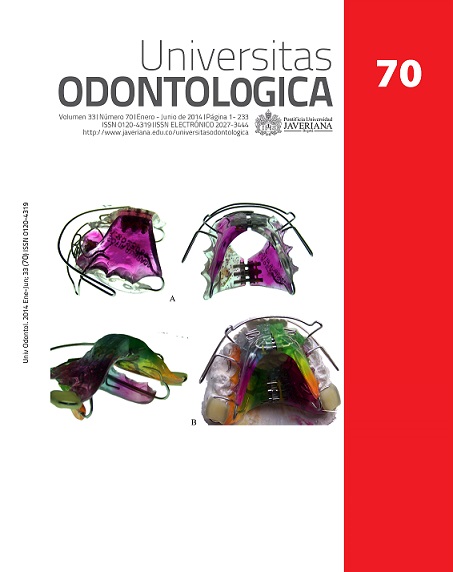Abstract
Background: The use of short elastics in the SN1 functional appliance for the correction of palatal plane has not been reported. Objective: To evaluate changes in the inclination of the palatal plane with the use of short elastics in the SN1 functional appliance at the Dentofacial Orthopedic clinic of the Fundación Universitaria CIEO in Bogotá, between 2004 and 2012. Methods: A retrospective observational analytical study was carried out. The sample consisted of 21 4-to-12-year-old patients who presented overbite < 2 mm, palatal plane –0.1 mm, and used the functional orthopedic appliance SN1 with short elastics located in the last molar present for an 8-15 month period. Initial and control radiographs were taken. Cephalometric measurements included: factor 4 (palatal plane inclination), factor 3 (mandibular plane inclination), angle B (maxillary-mandibular angle), facial biotype according to Bimler, Frankfurt plane-anterior nasal spine (ENA) distance, Frankfurt plane-posterior nasal spine (ENP) distance, and overbite. Results: Statistically significant increase in factor 4 (p = 0.000), factor 3 (p = 0.04), ENP-ENA to Frankfurt plane distance (p = 0.00), and overbite (p = 0.61) were observed after the use of the short elastics in the SN1 functional appliance. Conclusion: The use of short elastics produced a parallelization of the palatal plane over Frankfurt, after 8-15 months of use. Likewise, it caused a change in the mandibular plane by increasing their height and improving the overbite.
KEYWORDS
malocclusion; overbite; palatal plane; functional appliance; SN1; short elastics
This journal is registered under a Creative Commons Attribution 4.0 International Public License. Thus, this work may be reproduced, distributed, and publicly shared in digital format, as long as the names of the authors and Pontificia Universidad Javeriana are acknowledged. Others are allowed to quote, adapt, transform, auto-archive, republish, and create based on this material, for any purpose (even commercial ones), provided the authorship is duly acknowledged, a link to the original work is provided, and it is specified if changes have been made. Pontificia Universidad Javeriana does not hold the rights of published works and the authors are solely responsible for the contents of their works; they keep the moral, intellectual, privacy, and publicity rights.
Approving the intervention of the work (review, copy-editing, translation, layout) and the following outreach, are granted through an use license and not through an assignment of rights. This means the journal and Pontificia Universidad Javeriana cannot be held responsible for any ethical malpractice by the authors. As a consequence of the protection granted by the use license, the journal is not required to publish recantations or modify information already published, unless the errata stems from the editorial management process. Publishing contents in this journal does not generate royalties for contributors.


